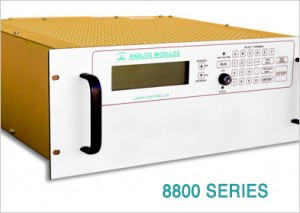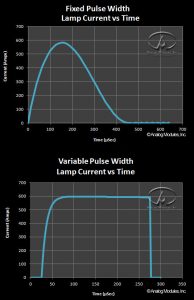Flashlamp Controller Built for your Application
AMI’s unique mix of electronics and laser system expertise allow us to design and build flashlamp controllers to our customer’s specific operating conditions. AMI manufactures fixed pulse width and variable pulse width controllers.
Based on a modular design approach, each controller is optimized for a given application or specific customer need. The 8800 and 8800V series provide a capacitor charging power supply, pulse forming network, simmer supply and all the electronic circuitry needed to drive flashlamps for pumping solid-state lasers.
Software control allows easy adjustment of operating parameters such as pulse energy, pulse repetition rate, pulse width, and mode of operation. Complete control of timing signals for multiple lamp and Q-switched applications is also provided by the embedded software.
End users can chose to to operate and program the flashlamp controller using a front panel push-button interface, RS-232 input or externally through a simple 25 pin D remote interface. The system status is presented on an easy-to-read LCD graphics display
To design a flashlamp controller for your application AMI needs the following information:
- Pulse width or range

- Maximum repetition rate and/or duty cycle
- Energy delivered to the lamp per pulse
- Lamp arc length
- Lamp bore diameter
- Lamp gas type
- Lamp fill pressure
Fixed verses Variable Pulse width Flashlamp Controller
Outside of the obvious there are several key differences between Fixed and Variable pulse width systems.
Fixed systems discharge a large capacitor switched by a SCR through an inductor delivering a Gaussian shaped current pulse to the lamp. The impedance of the lamp, Ko, has less of an impact on the shape of the current pulse.
Variable pulse width flashlamp controller uses an electronic PFN. A capacitor bank stores a large amount of energy. That energy is released into the lamp using an IGBT to switch the current flow on and off. The resultant current pulse is typically is square. The risetime of the pulse is effected by the impedance of the lamp and the charge voltage of the capacitor bank. As the voltage decreases and/or the application uses a low impedance lamp the rise time will slow eventually resulting in a shark fin rather than a square shaped pulse.
We look forward for to learning about your requirements for a Flashlamp Controller. Please contact AMI to discuss your application today.
© Analog Modules Inc., December 2016. This post may be reproduced in its entirety without editing.

 sales@analogmodules.com
sales@analogmodules.com 1-407-339-4355
1-407-339-4355


 Hybrid eyesafe laser rangefinder receiver is designed for laser rangefinding & surveying equipment. Compact construction is ideal for miniature applications. Fast recovery from T0 overload allows ranging to close objects without compromising long range performance. The incorporation of an InGaAs APD gives very high sensitivity with time programmed gain to minimize false targets. Operation at both 1.06 µm and 1.54 µm is possible over a wide range of pulse widths.
Hybrid eyesafe laser rangefinder receiver is designed for laser rangefinding & surveying equipment. Compact construction is ideal for miniature applications. Fast recovery from T0 overload allows ranging to close objects without compromising long range performance. The incorporation of an InGaAs APD gives very high sensitivity with time programmed gain to minimize false targets. Operation at both 1.06 µm and 1.54 µm is possible over a wide range of pulse widths.
